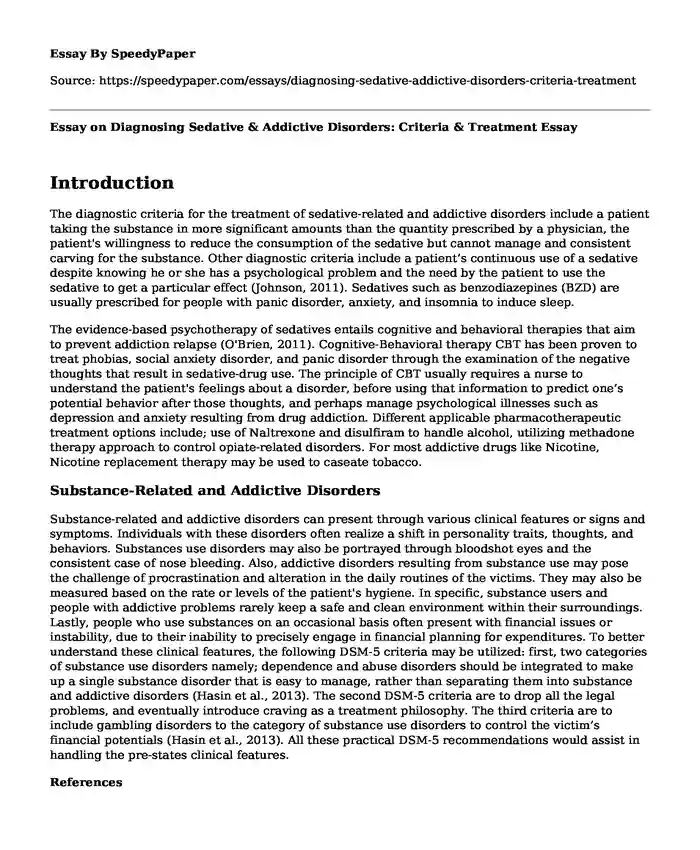Introduction
The diagnostic criteria for the treatment of sedative-related and addictive disorders include a patient taking the substance in more significant amounts than the quantity prescribed by a physician, the patient's willingness to reduce the consumption of the sedative but cannot manage and consistent carving for the substance. Other diagnostic criteria include a patient’s continuous use of a sedative despite knowing he or she has a psychological problem and the need by the patient to use the sedative to get a particular effect (Johnson, 2011). Sedatives such as benzodiazepines (BZD) are usually prescribed for people with panic disorder, anxiety, and insomnia to induce sleep.
The evidence-based psychotherapy of sedatives entails cognitive and behavioral therapies that aim to prevent addiction relapse (O'Brien, 2011). Cognitive-Behavioral therapy CBT has been proven to treat phobias, social anxiety disorder, and panic disorder through the examination of the negative thoughts that result in sedative-drug use. The principle of CBT usually requires a nurse to understand the patient's feelings about a disorder, before using that information to predict one’s potential behavior after those thoughts, and perhaps manage psychological illnesses such as depression and anxiety resulting from drug addiction. Different applicable pharmacotherapeutic treatment options include; use of Naltrexone and disulfiram to handle alcohol, utilizing methadone therapy approach to control opiate-related disorders. For most addictive drugs like Nicotine, Nicotine replacement therapy may be used to caseate tobacco.
Substance-Related and Addictive Disorders
Substance-related and addictive disorders can present through various clinical features or signs and symptoms. Individuals with these disorders often realize a shift in personality traits, thoughts, and behaviors. Substances use disorders may also be portrayed through bloodshot eyes and the consistent case of nose bleeding. Also, addictive disorders resulting from substance use may pose the challenge of procrastination and alteration in the daily routines of the victims. They may also be measured based on the rate or levels of the patient's hygiene. In specific, substance users and people with addictive problems rarely keep a safe and clean environment within their surroundings. Lastly, people who use substances on an occasional basis often present with financial issues or instability, due to their inability to precisely engage in financial planning for expenditures. To better understand these clinical features, the following DSM-5 criteria may be utilized: first, two categories of substance use disorders namely; dependence and abuse disorders should be integrated to make up a single substance disorder that is easy to manage, rather than separating them into substance and addictive disorders (Hasin et al., 2013). The second DSM-5 criteria are to drop all the legal problems, and eventually introduce craving as a treatment philosophy. The third criteria are to include gambling disorders to the category of substance use disorders to control the victim’s financial potentials (Hasin et al., 2013). All these practical DSM-5 recommendations would assist in handling the pre-states clinical features.
References
Hasin, D. S., O’Brien, C. P., Auriacombe, M., Borges, G., Bucholz, K., Budney, A., ... & Schuckit, M. (2013). DSM-5 criteria for substance use disorders: recommendations and rationale. American Journal of Psychiatry, 170(8), 834-851. https://ajp.psychiatryonline.org/doi/abs/10.1176/appi.ajp.2013.12060782
Johnson, B. A. (2011). Addiction medicine. Science and Practice. Springer.
O'Brien, C. P. (2011). Evidence-based treatments of addiction. Focus, 9(1), 107-117.
Weaver M. F. (2015). Prescription Sedative Misuse and Abuse. The Yale journal of biology and medicine, 88(3), 247–256.
Cite this page
Essay on Diagnosing Sedative & Addictive Disorders: Criteria & Treatment. (2023, Sep 11). Retrieved from https://speedypaper.com/essays/diagnosing-sedative-addictive-disorders-criteria-treatment
Request Removal
If you are the original author of this essay and no longer wish to have it published on the SpeedyPaper website, please click below to request its removal:
- Essay Sample: Administration of Adalimumab (Humira)
- Essay Sample on Physiological Mechanism Underlying the Stress Symptoms
- Essay Sample on Cause and Effect of Cigarette Smoking
- Essay Example: Crash Cart Design, Contents, and Arrangements
- 5-Year Professional Plan: Healthcare Goals for Career Growth - Essay Sample
- Essay on Effective Health Care Organization
- Shortage in Venezuela after Covid-19 - Essay Sample
Popular categories





